Melissa Kluger, Precedent’s editor-in-chief and publisher, spoke to some of Bay Street’s best-dressed lawyers to find out what it means to dress for the job. The conversation features: Peter Sullivan (Cassels), Emma Williamson (Dentons), Leila Rafi (McCarthys) and Jonathan Ip (Bennett Jones).
Melissa: As you know, Precedent prides itself on being a magazine about both law and style. For this special fashion issue, we’ve assembled this panel of style-savvy Bay Street lawyers to go on the record with their candid opinions and advice for looking good at work. Thank you for joining me this morning. Let’s start with something that just came up in your introductions. Peter says he doesn’t wear a tie to work very often. What would you say you’re wearing every day? What does it look like at big Bay Street law firms right now?
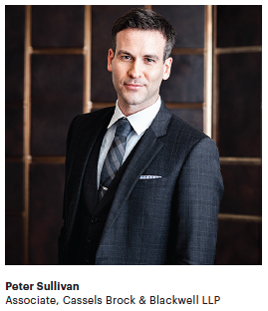 Peter: What you’re seeing is a lot more casual dress. At our firm, it depends on the floor or the group that you’re in. Some partners come in to the office in jeans and a sweater or even a T-shirt — and not on a Friday. Obviously, that’s uncommon, but I do see it becoming more casual. Mind you, this week, today is the first time I wore a tie. But I always keep a tie on the back of the door.
Peter: What you’re seeing is a lot more casual dress. At our firm, it depends on the floor or the group that you’re in. Some partners come in to the office in jeans and a sweater or even a T-shirt — and not on a Friday. Obviously, that’s uncommon, but I do see it becoming more casual. Mind you, this week, today is the first time I wore a tie. But I always keep a tie on the back of the door.
Leila: I always have a black blazer on the back of my door, but I don’t even own a pantsuit. That hasn’t changed since I’ve been practising. I wear the blazer to meetings, but I immediately take it off after I sit down. If somebody wore jeans on a Tuesday, which I’ve done before after spilling coffee on my dress, they do get a bit of a look.
Peter: I’m seeing a lot more women wearing flats at the office, whereas even two years ago, when I first got here, high heels were worn every day.
Melissa: Are there examples of an item you wouldn’t have worn when you walked in the door that you do wear now or that you aspire to wear a few years down the road?
Leila: For me, I wouldn’t wear three- or four-inch heels at the beginning. I would start with one or two inches. And at my office there are women who wear much higher heels than that and they pull it off and it looks great. But four inches is my maximum.
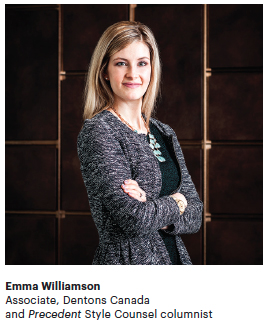 Emma: Mine would probably be colour. At first, I wore a lot of neutrals. In one Precedent column I talked about this green silk jacket that I love. I wouldn’t have worn it at first, but now I do.
Emma: Mine would probably be colour. At first, I wore a lot of neutrals. In one Precedent column I talked about this green silk jacket that I love. I wouldn’t have worn it at first, but now I do.
Peter: When I was very junior, even on casual Friday, I didn’t want to be called to a meeting wearing jeans, so I wore a suit every day. Second year I was probably confident enough that I would wear jeans on a casual Friday, but I always had a suit available if I needed one on short notice.
Jonathan: I think partners are able to wear more of what they want. They are at that level where they aren’t as worried about how they look in the office. But if they are going to meet clients or do business outside the office, they are almost always in suits.
Melissa: What would be your advice to someone who says, ‘I don’t know where to shop and I don’t care to know. I’m willing to spend the money, but I don’t have the time or interest.’
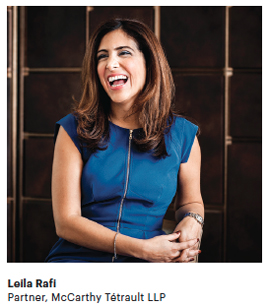 Leila: I have a personal shopper and she pushes me to wear stuff that I wouldn’t normally wear. And if you like the way someone dresses you can ask them, ‘Where do you get that? I’m wondering where I should go.’ If you’re not interested in fashion, you shouldn’t need to feel like you have to fake it or wear a colour if you really hate wearing that colour. Some people just aren’t interested in fashion. Nobody is going to hold you back for that.
Leila: I have a personal shopper and she pushes me to wear stuff that I wouldn’t normally wear. And if you like the way someone dresses you can ask them, ‘Where do you get that? I’m wondering where I should go.’ If you’re not interested in fashion, you shouldn’t need to feel like you have to fake it or wear a colour if you really hate wearing that colour. Some people just aren’t interested in fashion. Nobody is going to hold you back for that.
Emma: It’s not necessarily about dressing fashionably, but dressing well, in a way that flatters your body type: the cut’s good, the fabric’s nice, you look polished and professional. I heard a story of someone who was passed up for partnership partly because they were sort of dishevelled-looking, among other reasons. It’s not like they wore the wrong jacket.
Melissa: Has anyone seen any particular fashion blunders?
Leila: I think a tight, short skirt with patterns should never ever, ever, ever be worn.
Emma: Short skirts with high heels. I think if you’re going to do a shorter skirt, you’ve got to absolutely wear a sleek, refined flat and, say, an opaque pair of tights. And don’t wear flats that are frumpy: the sort of clunky, casual flat — I do see those a lot.
Peter: I don’t love paisley. It doesn’t have a place in the office. In my opinion it’s in curtains, or maybe wallpaper.
Melissa: What about certain accessories like bow ties?
Jonathan: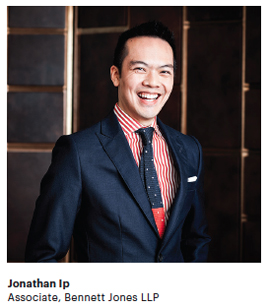 I have worn a bow tie to work. I like them. As long as you’re confident with it. I think it always goes back to being confident in what you’re wearing.
I have worn a bow tie to work. I like them. As long as you’re confident with it. I think it always goes back to being confident in what you’re wearing.
Peter: Right now, it’s more of a casual accessory. I’ve seen a bow tie worn casually. I guess it’s kind of hipster.
Leila: A lot of people wear cufflinks. I wear cufflinks too; I don’t think they’re just for men. I don’t love dress shirts on women, but I have three and when I wear them I have cufflinks.
Melissa: Can men have facial hair at work?
Peter: Facial hair is fine, as long as it’s kempt. Your neck is shaved. If you’re going to have a beard, you have a nice neat beard and not a long beard. A moustache: only in Movember.
Jonathan: It’s fine as long as it doesn’t look like you just forgot to shave for a week and left it that way. It comes back to taking care of yourself.
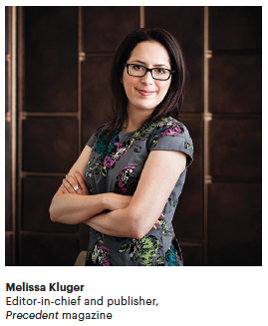
Melissa: Who are you trying to impress at work? Who do you dress for?
Peter: It is always your client; it just depends on who your client is and at what point in your career you’re at.
Emma: On a daily basis, I’m usually not meeting with clients in person. When I do meet with external clients or give a presentation, I wear a suit or dress and a blazer. I dress for myself but I’m cognizant of the impact I’m making on the people I work with.
Leila: When you’re junior, your clients are the firm’s senior associates, because you’re not — especially at a big firm — put in front of clients. Those are the lawyers you’re servicing. They’re giving you work and you want more. So prove to them that you’re capable of handling it. Acting and looking like a professional helps give you the confidence to be a professional.
Jonathan: It’s kind of scary, but you have to fake it ’til you make it. So you start by dressing the part. Subconsciously, you want the way you dress to say, ‘I know what the problem is. Here’s what you need to do.’ You want to communicate that you’re confident in your skills. And at the end of the day, you will be. You just have to get there.
This story is part of The Precedent guide to looking polished.
Moderated by Melissa Kluger; Transcribed by Sebastien Bell; Photography by Margaret Mulligan; Shot on location at Stratus restaurant.


